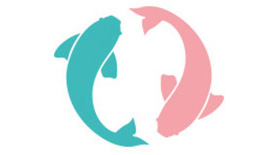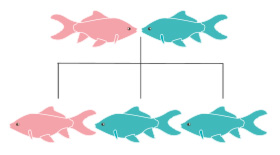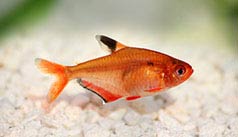

Alternative species (click on the thumbnail to see the card)
Names
Scientific name
Hyphessobrycon socolofi
Common name
Lesser Bleeding Heart Tetra
Spotfin tetra
Spot Fin tetra
Origin

Origin: Brazil (Rio Negro)
Biotope: Amazonian
Dimorphism

The male is more colourful and smaller than the female.
Group

Characidae
Volume

120 L / 26 Imp Gal / 32 US Gal
Parameters

T°: 24 to 27°C or 75 to 81°F
pH: 6 to 7
Hardness: 8 to 15°dGH
Difficulty

Easy
Size

5cm (2")
Longevity

8 years
Living zone

Middle
Individuals

6
Food
How to feed the Bleeding heart tetra?
Food
How to feed the Bleeding heart tetra?
Like all Hyphessobrycons, the Socolofi is omnivorous. To give it beautiful colours, vary its meals as much as possible. It's quite easy since it will accept anything you offer it! Alternate between live or frozen prey, flakes or pellets.
Behavior
What kind of behavior does the Bleeding heart tetra have?
Behavior
What kind of behavior does the Bleeding heart tetra have?
The Hyphessobrycon Socolofi is a calm fish that swims quietly in the middle part of the aquarium.
It is gregarious, i.e. it absolutely needs a certain number of its congeners to live properly. The union minimum is to keep a group of 6 to 8 fish in at least 120 L / 26 Imp Gal / 32 US Gal of water, but the more fish the better (within the limit of your volume of course)! Below 6, the fish become stressed, sensitive and fearful, sometimes aggressive. Moreover, this also harms their physical health as they become more prone to disease.
Cohabitation
Who can live with the Bleeding heart tetra?
Cohabitation
Who can live with the Bleeding heart tetra?
For a community aquarium, it can be interesting to put the Hyphessobrycon Socolofi in the company of other Grouse. The association with certain groundfish such as the Ancistrus will not be a problem. On the other hand, avoid Corydoras which do not require the same aquarium configuration. Shrimp will be used as a meal.
Breeding
How to breed the Bleeding heart tetra?
Breeding
How to breed the Bleeding heart tetra?
To breed this species, prepare a small breeding aquarium with a small filter on peat and many plants with fine leaves such as Java moss (it will be used as a laying support, a refuge for the fry and as a food reserve). There is no need for lighting as the eggs are afraid of light.
Choose two beautiful males and a female (the males are smaller and slightly more colourful than the female) and introduce them into the breeding aquarium. The two males will parade and compete for the female's favours. This activity will stimulate her to breed. Remove the losing male if his rival's aggressiveness is too great. Spawning should occur within the next 24 hours.
Once spawning has taken place, quickly remove the parents as they will eat their eggs. Keep the aquarium as dark as possible during incubation time because light deteriorates the eggs. Hatching takes place 24/48 hours after laying. The fry swim freely after 3 to 5 days.
Feeding of the fry: artemia nauplia.
Its aquarium
Which aquarium for the Bleeding heart tetra?
Its aquarium
Which aquarium for the Bleeding heart tetra?
In its natural habitat, this fish lives in acidic waters. This is due to the decomposition of plants that change the chemistry of the river (Rio Negro) and becomes acidic. This phenomenon also changes the colour of the water, which becomes brown (this is called "black water").
To recreate aquarium conditions and simulate black water, set up a peat filtration system.
You can also litter the floor with dried tree leaves, such as oak or beech.
The plants will be part of the decor because the Hyphessobrycon Socolofi likes to take refuge there in case of danger. However, large areas for free swimming must be provided. To balance this, install thick, supplied plant thickets in the corners of the aquarium and on the bottom. Surface plants are welcome, naturally dimming the lighting (which the Hyphessobrycon does not like too much).
On the material side, choose a filtration rate equal to 1 or 2 times the total volume of your tank per hour.
To maintain good water quality, change the water regularly.
Good To know
Find all additional information!
Good To know
Find all additional information!
It gets its name "bleeding heart" because of the red spot in the middle of its body. In fact, another species also bears this characteristic mark and is also called "bleeding heart" (Hyphessobrycon erythrostigma). Confusion quickly occurred so note that they can be distinguished because the Hyphessobrycon Socolofi has shorter fins and is smaller than the Hyphessobrycon erythrostigma.
Yours photos!
Comments
Sort by:
Please login to post comments




